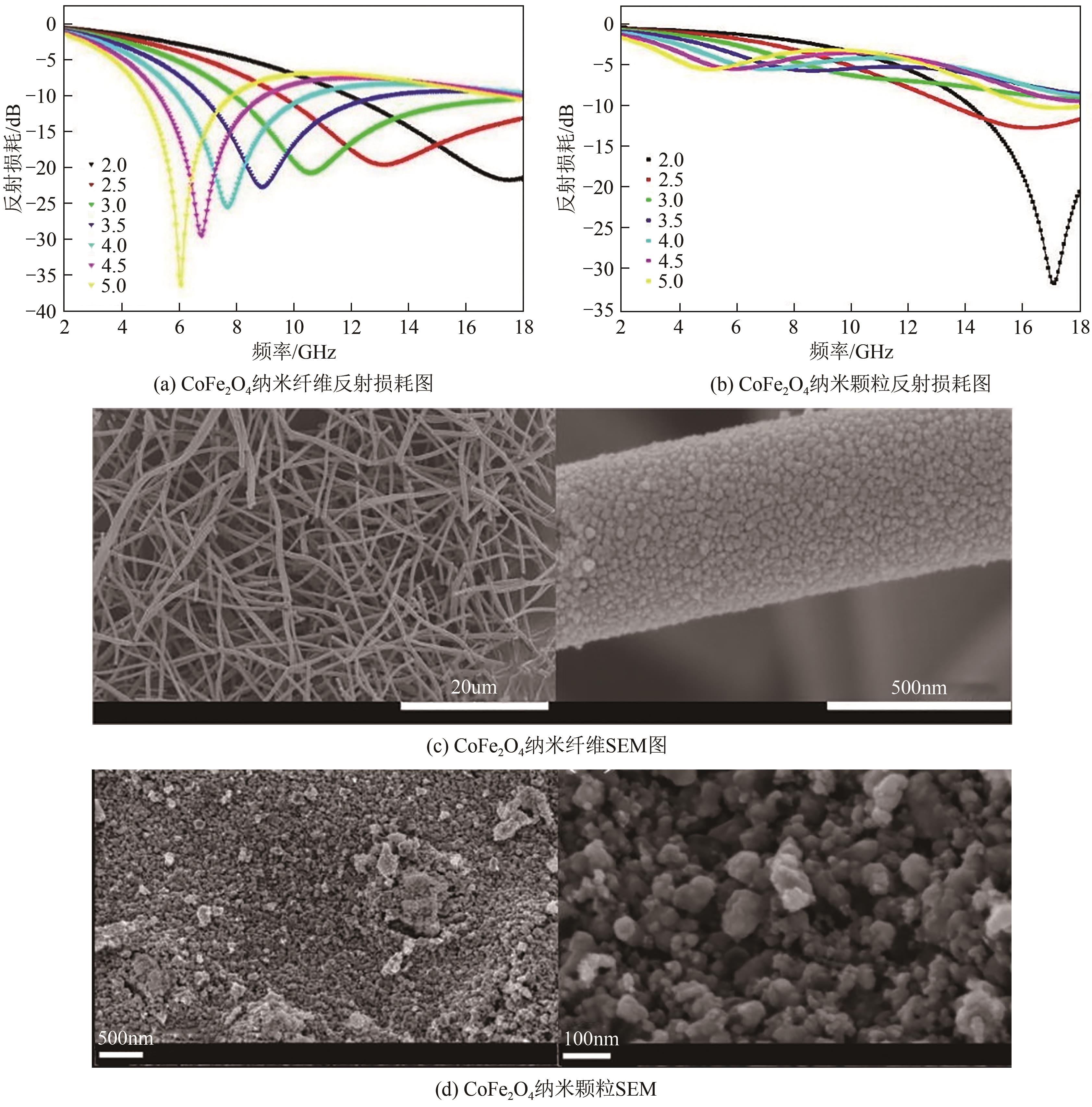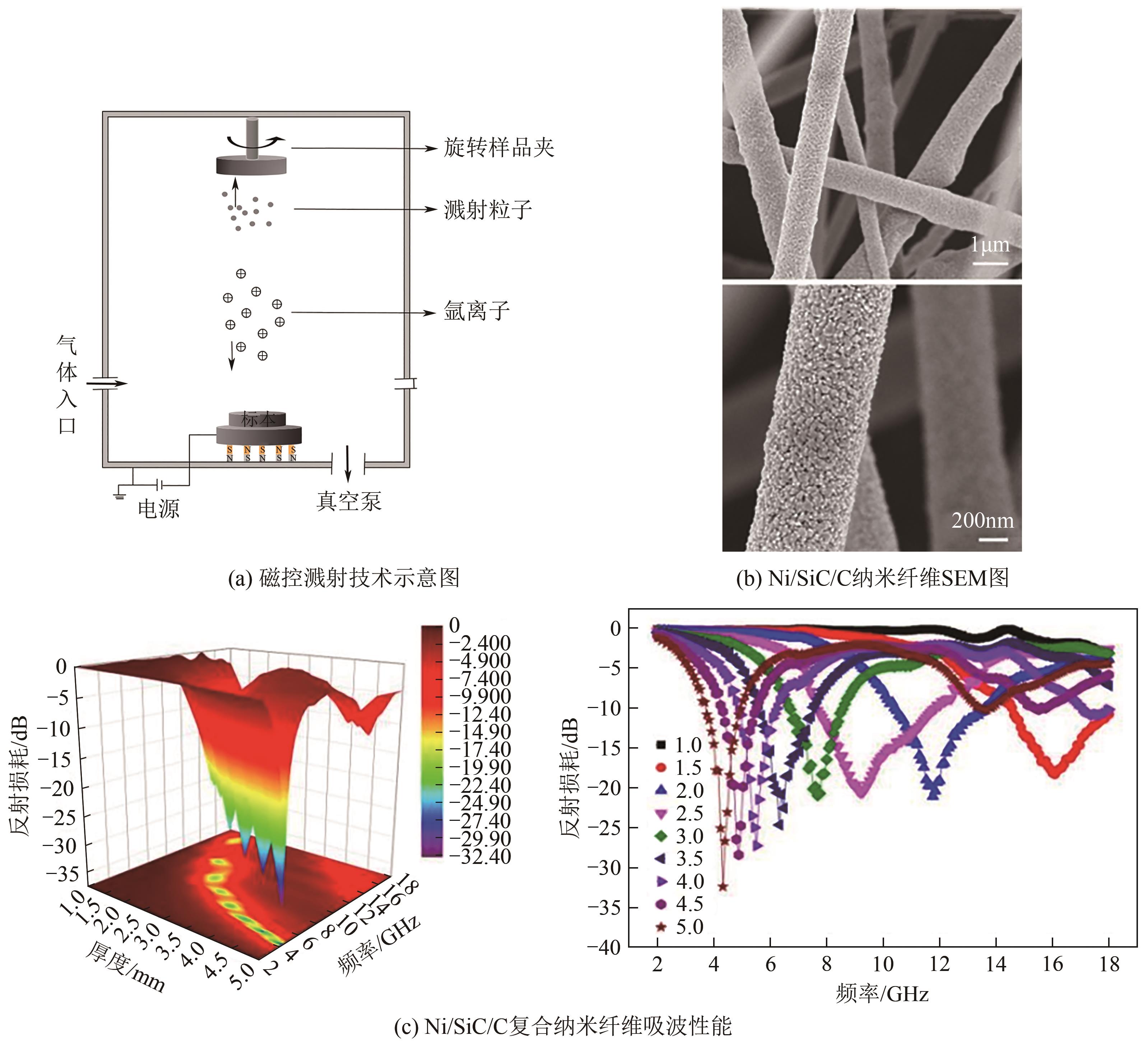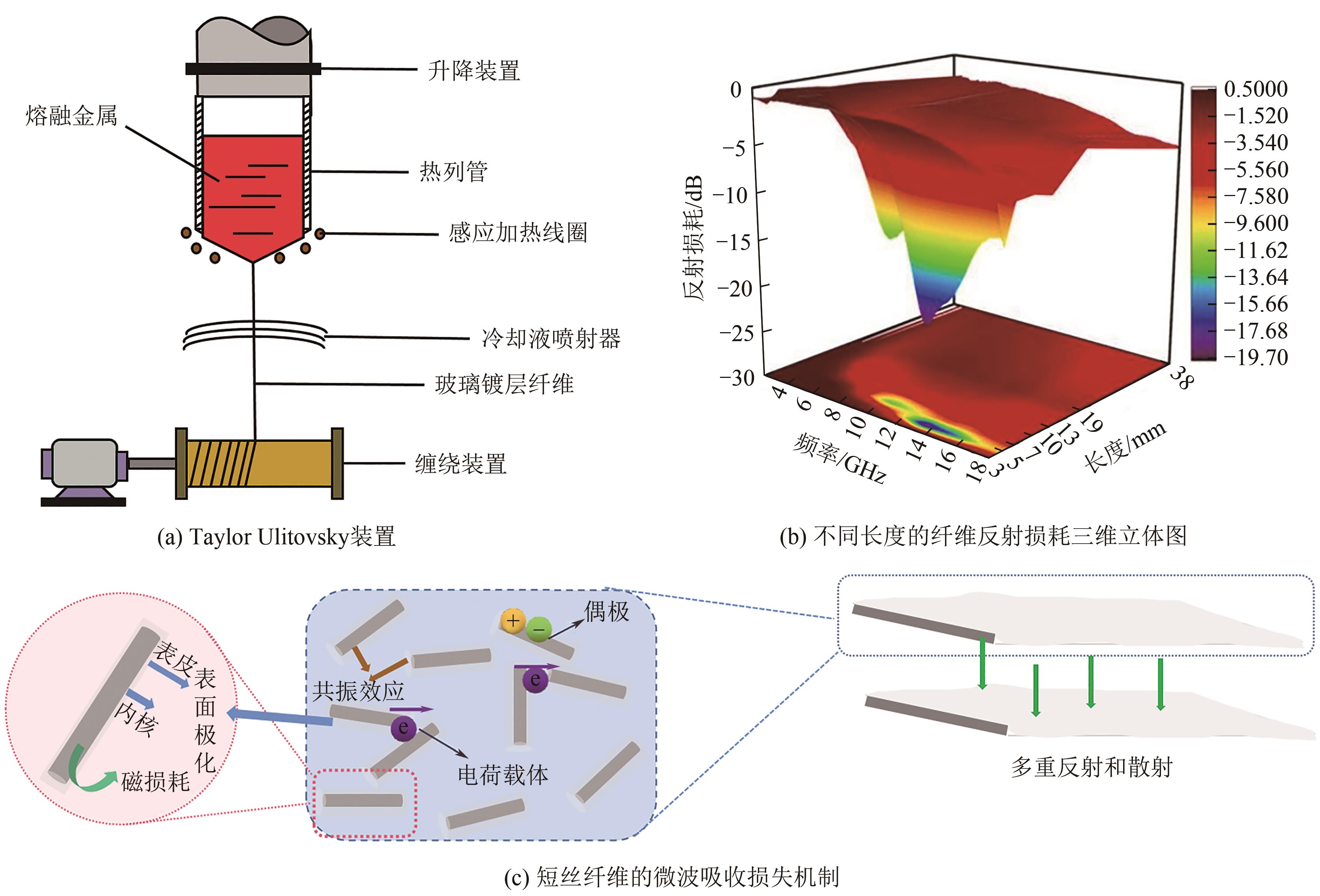Chemical Industry and Engineering Progress ›› 2023, Vol. 42 ›› Issue (10): 5310-5321.DOI: 10.16085/j.issn.1000-6613.2022-2223
• Materials science and technology • Previous Articles Next Articles
Advances in research on magnetic fibrous electromagnetic wave absorbers
YE Hao1( ), HU Ping2, WANG Ce3, LIU Yong4(
), HU Ping2, WANG Ce3, LIU Yong4( )
)
- 1.Ecole de Chimie de Pékin, Beijing University of Chemical Technology, Beijing 100029, China
2.Department of Chemical Engineering, Tsinghua University, Beijing 100084, China
3.College of Chemistry, Jilin University, Changchun 130012, Jilin, China
4.College of Materials Science and Engineering, Beijing University of Chemical Technology, Beijing 100029, China
-
Received:2022-12-01Revised:2023-01-31Online:2023-11-11Published:2023-10-15 -
Contact:LIU Yong
磁性纤维电磁波吸收剂研究进展
- 1.北京化工大学巴黎居里工程师学院,北京 100029
2.清华大学化工系,北京 100084
3.吉林大学化学学院,吉林 长春 130012
4.北京化工大学材料科学与工程学院,北京 100029
-
通讯作者:刘勇 -
作者简介:叶好(2002—),女,硕士研究生,研究方向为高分子材料。E-mail:2019100064@buct.edu.cn。 -
基金资助:教育部产学合作协同育人项目(202102437003)
CLC Number:
Cite this article
YE Hao, HU Ping, WANG Ce, LIU Yong. Advances in research on magnetic fibrous electromagnetic wave absorbers[J]. Chemical Industry and Engineering Progress, 2023, 42(10): 5310-5321.
叶好, 胡平, 王策, 刘勇. 磁性纤维电磁波吸收剂研究进展[J]. 化工进展, 2023, 42(10): 5310-5321.
share this article
Add to citation manager EndNote|Ris|BibTeX
URL: https://hgjz.cip.com.cn/EN/10.16085/j.issn.1000-6613.2022-2223
| 类型 | 优点 | 缺点 | 复合材料 |
|---|---|---|---|
| 铁氧体纤维 | 性能稳定、来源广泛、易于制备 | 吸收带宽窄、阻抗匹配差 | Cu、Ce等金属、石墨烯 |
| 纳米纤维 | 高的机械强度和柔韧性;硬度高、耐高温、耐腐蚀、密度低 | 高温易氧化、吸波频带较窄、阻抗失配 | Co、Ni等金属、金属有机框架、碳纳米纤维 |
| 磁性非晶纤维 | 具有多重电磁损耗和合适的阻抗匹配,而且具有磁性的导电芯 | 制备工序复杂 | — |
| 类型 | 优点 | 缺点 | 复合材料 |
|---|---|---|---|
| 铁氧体纤维 | 性能稳定、来源广泛、易于制备 | 吸收带宽窄、阻抗匹配差 | Cu、Ce等金属、石墨烯 |
| 纳米纤维 | 高的机械强度和柔韧性;硬度高、耐高温、耐腐蚀、密度低 | 高温易氧化、吸波频带较窄、阻抗失配 | Co、Ni等金属、金属有机框架、碳纳米纤维 |
| 磁性非晶纤维 | 具有多重电磁损耗和合适的阻抗匹配,而且具有磁性的导电芯 | 制备工序复杂 | — |
| 1 | 李昌龄. 锦纶基磁性纺织品功能性研究[D]. 无锡: 江南大学, 2020. |
| LI Changling. Study on the function of nylon-based magnetic textiles[D]. Wuxi: Jiangnan University, 2020. | |
| 2 | 张华伟, 王炜. 吸波材料的最新研究现状及发展趋势[J]. 纺织导报, 2021(6): 95-96. |
| ZHANG Huawei, WANG Wei. The latest research status and development trend of absorbing materials[J]. China Textile Leader, 2021(6): 95-96, 98. | |
| 3 | 杨晴. 陶瓷基干涉型吸波材料的制备和性能研究[D]. 烟台: 烟台大学, 2022. |
| YANG Qing. Preparation and properties of ceramic-based interference absorbing materials[D]. Yantai: Yantai University, 2022. | |
| 4 | 李享成, 龚荣洲, 何华辉, 等. 磁性纤维吸收剂的国内外研究进展[J]. 兵器材料科学与工程, 2008, 31(5): 86-91. |
| LI Xiangcheng, GONG Rongzhou, HE Huahui, et al. Research progress in magnetic fibers-filled microwave absorbing materials[J]. Ordnance Material Science and Engineering, 2008, 31(5): 86-91. | |
| 5 | DEVI N P, MAISNAM M. Characterizations of sol-gel synthesized and high energy ball milled spinel nanoferrites: MFe2O4 (M = Li, Ni, Zn, Mn) for nanofluid preparations[J]. Integrated Ferroelectrics, 2020, 204(1): 133-141. |
| 6 | 李勤华. 高频磁铅石型铁氧体材料的制备及软磁特性研究[D]. 成都: 电子科技大学, 2022. |
| LI Qinhua. Preparation of magnetoplumbite ferrites and their soft magnetic properties for high frequency applications[D]. Chengdu: University of Electronic Science and Technology of China, 2022. | |
| 7 | 倪鹤年. 高功率低损耗石榴石微波铁氧体研究[D]. 成都: 电子科技大学, 2022. |
| NI Henian. Research on high power and low loss garnet microwave ferrite[D]. Chengdu: University of Electronic Science and Technology of China, 2022. | |
| 8 | 王彩霞, 刘元军. 磁损耗型吸波材料的发展现状[J]. 丝绸, 2021, 58(2): 27-34. |
| WANG Caixia, LIU Yuanjun. Developments status of magnetic loss wave-absorbing materials[J]. Journal of Silk, 2021, 58(2): 27-34. | |
| 9 | 陈卓. 静电纺丝制备Bi2SiO5/Bi2Fe4O9/C3N4多孔纤维及其性能研究[D]. 北京: 中国地质大学, 2020. |
| CHENZhuo. Preparation and properties of Bi2SiO5/Bi2Fe4O9/C3N4 porous fibers by electrospinning[D]. Beijing: China University of Geosciences, 2020. | |
| 10 | 马海宁. 金属氧化物/石墨烯复合材料的制备及其相关性能研究[D]. 西安: 西安工业大学, 2019. |
| MA Haining. Preparation of metal oxide/graphene composites and their related properties[D]. Xi’an: Xi’an Technological University, 2019. | |
| 11 | 冯一哲. 溶胶凝胶制备磁性纤维及其吸波性能研究[D]. 哈尔滨: 哈尔滨工业大学, 2019. |
| FENG Yizhe. Microwave absorption performance of magnetic fibers prepared by sol-gel method[D]. Harbin: Harbin Institute of Technology, 2019. | |
| 12 | 陈宇成. M型钡铁氧体结构及其吸波性能的研究[D]. 桂林: 桂林电子科技大学, 2022. |
| CHEN Yucheng. Study on the structure and absorbing properties of M-type barium ferrite[D]. Guilin: Guilin University of Electronic Technology, 2022. | |
| 13 | SHARMA V, SAHA J, PATNAIK S, et al. YIG based broad band microwave absorber: A perspective on synthesis methods[J]. Journal of Magnetism and Magnetic Materials, 2017, 439: 277-286. |
| 14 | ZHOU Yao, CHEN Lyuyun, JIAN Mulin, et al. Recent research progress of ferrite multielement microwave absorbing composites[J]. Advanced Engineering Materials, 2022, 24(12): 2200526. |
| 15 | 张牧. 电/磁损耗型吸波材料的制备及性能研究[D]. 镇江: 江苏大学, 2021. |
| ZHANG Mu. Preparation and properties of electrical/magnetic loss absorbing materials[D]. Zhenjiang: Jiangsu University, 2021. | |
| 16 | GE Yaqing, LI Cuiping, JIANG Xiaohui, et al. ZnFe2O4@polypyrrole nanocomposites as an efficient broadband electromagnetic wave absorber at 2—40GHz[J]. Ceramics International, 2019, 45(11): 13883-13893. |
| 17 | GE Y Q, LI C P, WATERHOUSE G I N, et al. ZnFe2O4@SiO2@ polypyrrole nanocomposites with efficient electromagnetic wave absorption properties in the K and Ka band regions[J]. Ceramics International, 2021, 47(2): 1728-1739. |
| 18 | 吴梦, 饶磊, 张建峰, 等. MXene及其复合吸波材料的制备与性能研究进展[J]. 复合材料学报, 2022, 39(3): 942-955. |
| WU Meng, RAO Lei, ZHANG Jianfeng, et al. Research progress in preparation and performance of MXene and its composite absorbing materials[J]. Acta Materiae Compositae Sinica, 2022, 39(3): 942-955. | |
| 19 | ZHANG Zhiwei, CAI Zhihao, ZHANG Yi, et al. The recent progress of MXene-based microwave absorption materials[J]. Carbon, 2021, 174: 484-499. |
| 20 | PAN Fei, YU Lunzhou, XIANG Zhen, et al. Improved synergistic effect for achieving ultrathin microwave absorber of 1D Co nanochains/2D carbide MXene nanocomposite[J]. Carbon, 2021, 172: 506-515. |
| 21 | 王欣欣, 李凌, 刘慧, 等. PPy@Fe3O4@MXene复合材料吸波性能研究[J]. 机电产品开发与创新, 2021, 34(5): 115-117. |
| WANG Xinxin, LI Ling, LIU Hui, et al. Research on the absorbing properties of PPy@Fe3O4@MXene composites[J]. Development & Innovation of Machinery & Electrical Products, 2021, 34(5): 115-117. | |
| 22 | 李享成, 龚荣洲, 何华辉, 等. 磁性纤维吸收剂的国内外研究进展[J]. 兵器材料科学与工程, 2008, 31(5): 86-91. |
| LI Xiangcheng, GONG Rongzhou, HE Huahui, et al. Research progress in magnetic fibers-filled microwave absorbing materials[J]. Ordnance Material Science and Engineering, 2008, 31(5): 86-91. | |
| 23 | 曲冠达. Ni掺杂Fe基金属纤维组织结构及其力学、吸波性能研究[D]. 呼和浩特: 内蒙古工业大学, 2021. |
| QU Guanda. Research on microstructure, mechanical and microwave absorbing properties of Ni-doped Fe-based metallic microwires[D]. Hohhot: Inner Mongolia University of Technology, 2021. | |
| 24 | XU Xueqing, RAN Feitian, FAN Zhimin, et al. Bimetallic metal-organic framework-derived pomegranate-like nanoclusters coupled with CoNi-doped graphene for strong wideband microwave absorption[J]. ACS Applied Materials & Interfaces, 2020, 12(15): 17870-17880. |
| 25 | YAN Jing, HUANG Ying, YAN Yonghui, et al. The composition design of MOF-derived Co-Fe bimetallic autocatalysis carbon nanotubes with controllable electromagnetic properties[J]. Composites Part A: Applied Science and Manufacturing, 2020, 139: 106107. |
| 26 | ZHAO Xiaoxiao, YAN Jing, HUANG Ying, et al. Magnetic porous CoNi@C derived from bamboo fiber combined with metal-organic-framework for enhanced electromagnetic wave absorption[J]. Journal of Colloid and Interface Science, 2021, 595: 78-87. |
| 27 | 彭俊豪, 郭建华, 蒋兴华. 吸波弹性体材料的研究进展[J]. 弹性体, 2021, 31(4): 75-82. |
| PENG Junhao, GUO Jianhua, JIANG Xinghua. Research progress of microwave-absorbing elastomer materials[J]. China Elastomerics, 2021, 31(4): 75-82. | |
| 28 | 莫红松. 碳系复合材料的吸波性能和力学性能研究[D]. 上海:东华大学, 2008. |
| MO Hongsong. Study on microwave absorbing ability and mechanical properties of carbonous composites[D]. Shanghai: Donghua University, 2008. | |
| 29 | JIN Dan, YANG Xiaolong, WEI Ying. Preparation and enhancement microwave absorption properties of carbon fibers coated with CoNi alloy by solvothermal[J]. Journal of Materials Science: Materials in Electronics, 2022, 33(7): 4510-4522. |
| 30 | MA Mingliang, LIAO Zijian, SU Xuewei, et al. Magnetic CoNi alloy particles embedded N-doped carbon fibers with polypyrrole for excellent electromagnetic wave absorption[J]. Journal of Colloid and Interface Science, 2022, 608: 2203-2212. |
| 31 | YIN Pengfei, ZHANG Limin, WANG Jian, et al. Facile preparation of cotton-derived carbon fibers loaded with hollow Fe3O4 and CoFe NPs for significant low-frequency electromagnetic absorption[J]. Powder Technology, 2021, 380: 134-142. |
| 32 | LIU Peizhou, GAO Tiande, HE Wenjuan, et al. Electrospinning of hierarchical carbon fibers with multi-dimensional magnetic configurations toward prominent microwave absorption[J]. Carbon, 2023, 202: 244-253. |
| 33 | 李天天, 夏龙, 黄小萧, 等. 介电损耗型微波吸收材料的研究进展[J]. 材料工程, 2021, 49(6): 1-13. |
| LI Tiantian, XIA Long, HUANG Xiaoxiao, et al. Progress in dielectric loss microwave absorbing materials[J]. Journal of Materials Engineering, 2021, 49(6): 1-13. | |
| 34 | HUO Yashan, TAN Yujia, ZHAO Kang, et al. Enhanced electromagnetic wave absorption properties of Ni magnetic coating-functionalized SiC/C nanofibers synthesized by electrospinning and magnetron sputtering technology[J]. Chemical Physics Letters, 2021, 763: 138230. |
| 35 | 张天豪. 磁控溅射法制备TiO2电子传输层及其钙钛矿太阳能电池性能研究[D]. 景德镇: 景德镇陶瓷大学, 2022. |
| ZHANG Tianhao. Preparation of TiO2 electron transport layer by magnetron sputtering and its performance of perovskite solar cells[D]. Jingdezhen: Jingdezhen University of Ceramics, 2022. | |
| 36 | LARIN V S, TORCUNOV A V, ZHUKOV A, et al. Preparation and properties of glass-coated microwires[J]. Journal of Magnetism and Magnetic Materials, 2002, 249(1/2): 39-45. |
| 37 | DI Yongjiang, JIANG Jianjun, DU Gang, et al. Magnetic and microwave properties of glass-coated amorphous ferromagnetic microwires[J]. Transactions of Nonferrous Metals Society of China, 2007, 17(6): 1352-1357. |
| 38 | JI Hui, DAI Guoliang, CHEN Jianying, et al. Ultralight broadband microwave-absorbing materials based on the short fibers of glass-coated amorphous magnetic microwires[J]. Journal of Alloys and Compounds, 2022, 911: 164904. |
| [1] | XU Chunshu, YAO Qingda, LIANG Yongxian, ZHOU Hualong. Effects of graphene oxide/carbon nanotubes on the properties of several typical polymer materials [J]. Chemical Industry and Engineering Progress, 2023, 42(6): 3012-3028. |
| [2] | ZHANG Jianzhong, XU Sheng, FAN Jiashu, FEI Zhenyu, WANG Kun, HUANG Jian, CUI Fengbo, RAN Wenhua. Progress in characterization and analysis of glass fiber sizing [J]. Chemical Industry and Engineering Progress, 2023, 42(2): 821-838. |
| [3] | YANG Zhuangzhuang, LIU Yongjun, LIU Xingshe, LIU Zhe, YANG Lu, ZHANG Aining. Coalescence separation of oily sludge and removal effect of organic substances from coal chemical wastewater [J]. Chemical Industry and Engineering Progress, 2023, 42(1): 538-545. |
| [4] | QIN Jian, LIU Tianxia, WANG Jian, LU Xing. Preparation and tribological properties of oleic acid modified graphene/molybdenum disulfide composite lubricating additives [J]. Chemical Industry and Engineering Progress, 2022, 41(9): 4973-4985. |
| [5] | ZHENG Jinbao, LI Chen. Research progress in improving hydrophobicity of starch-based packaging materials [J]. Chemical Industry and Engineering Progress, 2022, 41(6): 3089-3102. |
| [6] | XIA Zhenguo, ZHU Yingying, CHEN Geng, LU Yu, WANG Jiafeng. Progress in preparation and modification of TiO2/AC composite photocatalysts for environmental purification [J]. Chemical Industry and Engineering Progress, 2021, 40(7): 3837-3846. |
| [7] | WANG Chengjun, SU Qiong, DUAN Zhiying, WANG Aijun, WANG Zhichao. Research progress of shape-stable composite phase change energy storage materials based on porous supports [J]. Chemical Industry and Engineering Progress, 2021, 40(3): 1483-1494. |
| [8] | Yanyan FENG, Yanjie LI, Wen YANG, Xiaodi NIU. Synthesis and capacitive properties of carbon sphere@nanosheet-like cobalt-nickel oxides core-shell structured composites [J]. Chemical Industry and Engineering Progress, 2020, 39(7): 2734-2741. |
| [9] | Xiaozhi XU, Biao LI, Kaiqiang SHI, Siyuan DONG, Zuchao JIN, Jingbin HAN. Recent advances in LDHs-based gas barrier materials [J]. Chemical Industry and Engineering Progress, 2020, 39(6): 2177-2186. |
| [10] | Xuexia GAO, Xi ZHOU, Meihong LIU, Yufeng MA, Jifu WANG, Chunpeng WANG, Fuxiang CHU. Carbon dots/Fe3+ composites for biosensor detection of ascorbic acid [J]. Chemical Industry and Engineering Progress, 2019, 38(07): 3326-3331. |
| [11] | Chaocheng ZHAO, Guangrui WU. Research progress on the mechanism and applications of MOFs composite materials for catalytic degradation of organic pollutants in the solution [J]. Chemical Industry and Engineering Progress, 2019, 38(04): 1775-1784. |
| [12] | ZU Liwu, WANG Xu, WANG Yazhen, WANG Yuwei, XU Shuangping, JIA Weinan. Preparation and application of layered graphene oxide/polypropylene-grafted-sulfonated styrene/polyaniline composites antistatic agent [J]. Chemical Industry and Engineering Progress, 2018, 37(11): 4370-4377. |
| [13] | XU Chong, ZHANG Xiaolin, CONG Longkang, DENG Xiangsheng, JIN Xiao, NIE Sunjian. Progress of natural fiber reinforced polylactic acid biodegradable composites [J]. Chemical Industry and Engineering Progress, 2017, 36(10): 3751-3756. |
| [14] | AI Xiaolin, CHEN Yandan, HUANG Biao, CHEN Xuerong. Progress in comprehensive utilization of loofah sponge fibers [J]. Chemical Industry and Engineering Progree, 2015, 34(06): 1708-1713,1729. |
| [15] | SHANG Baoyue1,YANG Shaobin2. Research progress of basalt fiber reinforced polymer composites [J]. Chemical Industry and Engineering Progree, 2011, 30(8): 1766-. |
| Viewed | ||||||
|
Full text |
|
|||||
|
Abstract |
|
|||||





